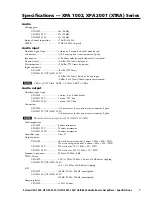
14
8) FRONT and REAR “Q” Controls
Once the FRONT highpass crossover point has been determined, use the
FRONT “Q” control to increase the bass information centered around the
crossover point.
Setting the front “Q” control is done in conjunction with setting the levels on
the input sensitivity and highpass crossover frequency controls. You may find
while setting the “Q” that bottoming may be detected in the front speakers;
lowering the “Q” input sensitivity or raising the highpass crossover point will
eliminate this. Minor adjustments to each setting are required to fine-tune the
system.
Setting the “Q” is a subtle process. It is recommended that the “Q” setting be left in the 0.7 position and
adjusted only after the input sensitivity and highpass crossover ranges are known. Small adjustments to the
“Q” setting are all that are required to fine-tune the system.
Setup Tuning—Full-Range Speakers (cont.)
9) REAR Input Sensitivity and Crossover Controls
Setting levels for the rear channels proceeds the same as for the
front except for the elimination of the “Q” control settings.
Crossover selector switch must be set to “HP” and filter switch
must be set to “ON.” If the loudspeaker being used is capable
of full-range operation, filter should be set to “OFF.”
Setup Tuning—Subwoofers
1) SUBWOOFER LEVEL Control
Refer to subwoofer level control in owner’s manual. If the control is not used, SUBWOOFER LEVEL switch
must be set to “OFF.”
2) SUBWOOFER Mode Switch
Move switch to left position (STEREO L-R) when used with L&R subwoofer RCA outputs. Move switch to mid-
dle position (MONO L) when used with single subwoofer RCA outputs. Move switch to right position when
subwoofer signal is to be derived from front and rear channels.
S U B WO O F E R L E V E L
O F F
O N
1 2 d B 2 4 d B
O F F
L OW PA S S
5 0
3 5 0
H z
2 0 0
All manuals and user guides at all-guides.com




































